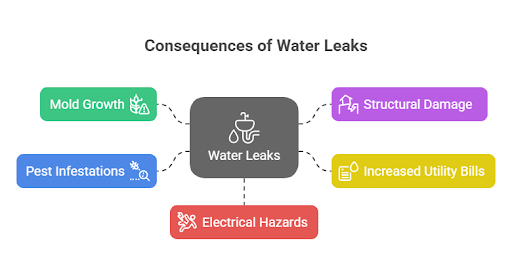In this article, we’re going to talk about smart water leak detectors.
Water leaks are among the most overlooked threats to homes. They can quietly cause thousands of dollars in damage, ruining floors, fostering mold, and even compromising the structure of your property. Fortunately, smart leak detectors offer a high-tech, proactive solution that alerts you before a small drip turns into a major disaster.
This article covers:
- Causes and consequences of water leaks
- What smart water leak detectors are and how they work
- The types of sensors used to detect leaks
- Where to install them for maximum protection
- Top smart leak detectors in 2025
Let’s get started!
Common Causes of Water Leaks
First off, let’s discuss what factors cause water leaks. Understanding the typical sources of water leaks can help in early detection and prevention:
1. Pipe Corrosion
Over time, pipes can corrode due to chemical reactions, leading to leaks. Corrosion weakens the pipe material, making it susceptible to cracks and holes. Regular inspection and maintenance can help identify and replace corroded pipes before they fail.
2. Loose or Broken Hose Connections
Appliances like washing machines and dishwashers can develop leaks at hose connections. These hoses can become loose or brittle over time, especially if not properly secured. Regularly checking and tightening hose connections can prevent unexpected leaks.
3. Clogged Drain Lines
Blockages can cause water to back up and leak from fixtures. Clogs are often caused by the accumulation of debris, grease, or foreign objects. Using drain guards and avoiding disposing of inappropriate items down the drain can reduce the risk of clogs.
4. Worn-Out Seals
Seals around fixtures can degrade, allowing water to escape. Over time, the rubber or silicone seals in faucets, toilets, and other fixtures can wear out or crack. Replacing worn seals promptly can prevent leaks and water damage.
5. High Water Pressure
Excessive pressure can strain pipes and joints, leading to leaks. High water pressure can cause pipes to burst or develop leaks at weak points. Installing a pressure regulator can help maintain safe water pressure levels in your plumbing system.
6. Tree Root Intrusion
Roots can infiltrate underground pipes, causing cracks and leaks. Tree roots naturally seek out moisture and can penetrate small cracks in pipes, eventually causing significant damage. Regular inspection of underground pipes and careful landscaping can mitigate this risk.
7. Frozen Pipes
In colder climates like Philadelphia, water can freeze in pipes, causing them to burst. When water freezes, it expands, putting pressure on the pipe walls. Insulating pipes and keeping indoor temperatures above freezing can prevent this issue.
Consequences of Water Leaks
Ignoring water leaks can lead to:
1. Mold Growth
Persistent moisture creates an ideal environment for mold, which can pose health risks. Mold spores can cause allergic reactions and respiratory issues. Promptly addressing leaks and drying affected areas can prevent mold proliferation.
2. Structural Damage
Water can weaken walls, floors, and foundations, compromising the integrity of your home. Prolonged exposure to moisture can cause wood to rot and metal to corrode. Regular inspections and maintenance can help identify and repair damage early.
3. Increased Utility Bills
Even minor leaks can waste significant amounts of water, leading to higher bills. A dripping faucet or running toilet can waste thousands of gallons annually. Fixing leaks promptly can result in substantial savings.
4. Pest Infestations
Damp areas attract pests like termites and cockroaches. These pests thrive in moist environments and can cause additional damage to your home. Eliminating leaks and maintaining dry conditions can deter infestations.
5. Electrical Hazards
Water intrusion can lead to short circuits and fire risks. Water can corrode electrical wiring and components, posing serious safety hazards. Ensuring that leaks are addressed promptly can prevent electrical issues.
According to the Insurance Information Institute, between 2018 and 2022, water damage and freezing claims cost homeowners an average of nearly $14,000.
What Are Smart Water Leak Detectors?
Smart water leak detectors are devices designed to identify the presence of water in areas where it shouldn’t be. They alert homeowners to potential leaks, allowing for swift action to prevent damage.
These detectors typically use sensors to monitor moisture levels. When water is detected, they send alerts via smartphone apps, emails, or audible alarms. Some advanced models can even shut off the water supply automatically to prevent further damage.
Types of Smart Water Leak Detectors
- Point-of-Use Detectors: Placed near appliances or fixtures prone to leaks, like under sinks or near water heaters.
- Whole-Home Systems: Installed on the main water line, these systems monitor the entire home’s water usage and can detect anomalies indicating leaks.
Sensing Mechanisms
Smart water leak detectors rely on one or more of the following sensor types to identify leaks:
1. Moisture Sensors (Capacitive or Resistive)
How they work:
These are the standard sensors in most leak detectors. They detect the physical presence of water when it bridges two or more conductive surfaces. There are two types:
- Resistive sensors detect water based on changes in resistance between metal contacts.
- Capacitive sensors measure changes in capacitance when moisture is present.
Use case:
Ideal for under sinks, near washing machines, or basement floors—anywhere surface-level water may appear.
2. Temperature Sensors
How they work:
Measure ambient temperature or water temperature to detect freezing conditions or overheat events.
Use case:
Extremely useful in colder climates. These sensors can alert homeowners before pipes freeze, enabling preventive action.
3. Flow Sensors
How they work:
Installed on the main water line, these measure the rate and volume of water flowing through your plumbing. Sudden spikes, long continuous flow, or irregular patterns indicate a potential leak.
Use case:
Great for whole-home monitoring. Helps catch both large breaks and slow leaks that might otherwise go unnoticed.
4. Pressure Sensors
How they work:
Monitor the water pressure within pipes. Unusual pressure drops or spikes can signal pipe damage or blockages.
Use case:
Helpful for detecting issues before water escapes. Pressure anomalies can indicate hidden leaks or failing appliances.
Real-world example:
The Flo by Moen system includes pressure sensors that allow for advanced diagnostics and water system health reporting.
5. Humidity Sensors
How they work:
Measure the relative humidity in the air. A rising trend can indicate slow leaks, evaporating water, or nearby condensation buildup.
Use case:
Especially useful in crawl spaces, attics, or behind walls where leaks don’t create puddles but increase ambient humidity.
Bonus: These sensors also help detect mold risk, even when standing water isn’t visible.
6. Ultrasonic Flow Sensors
How they work:
Use ultrasonic pulses to measure water flow rate without any moving parts. Sound waves are sent across the pipe, and the difference in travel time upstream vs. downstream determines flow speed.
Use case:
Highly accurate and long-lasting. Common in commercial or high-end residential leak detection systems.
7. Acoustic Sensors (Leak Noise Detection)
How they work:
These sensors listen for high-frequency sounds or vibrations produced by pressurized water escaping from pipes. Often used in municipal and commercial applications, they can detect leaks behind walls or underground.
Use case:
Not standard in residential units but gaining popularity. Emerging AI-powered acoustic leak detection is becoming more accessible in smart home hubs.
8. Infrared (IR) and Thermal Imaging Sensors (experimental/advanced)
How they work:
Some advanced detectors or integrations with smart home cameras can use thermal imaging to detect temperature anomalies caused by water flow inside walls or ceilings.
Use case:
Primarily for professionals or part of smart home security systems that monitor water and fire safety simultaneously.
9. Water Conductivity Profiling
How it works:
Some smart leak detectors not only sense water but analyze what type of water it is. By measuring conductivity or mineral content, they distinguish between tap water, rainwater, or wastewater.
Use case:
Useful in basements, laundry rooms, or flood-prone zones. Helps determine whether a leak is plumbing-related or caused by stormwater intrusion.
10. Smart AI Pattern Recognition (Not a Sensor, but Enhancer)
How it works:
Using cloud-based analytics, AI systems learn your home’s daily water usage patterns. Deviations, even subtle ones, trigger alerts. Combined with sensors, this adds a predictive layer to detection.
Use case:
Great for second homes, vacation properties, or Airbnb units where no one is physically present to notice leaks.
Table 1: Smart Water Leak Detectors Sensing Mechanism
| Sensor Type | Detects | Typical Use Case | Product Example & Link |
| Moisture (Resistive) | Standing water | Under appliances, basements | 5 Pack Water Leak Detectors for Home, 100dB Water Sensor Alarm |
| Flow | Unusual water usage | Main water line, full-home coverage | Moen Flo Smart Water Monitor and Automatic Shutoff Sensor, Wi-Fi |
| Pressure | Drops/spikes in water pressure | Pipe health monitoring | Moen Flo Smart Water Monitor and Automatic Shutoff Sensor, Wi-Fi |
| Temperature | Freezing pipes | Crawl spaces, garages | Honeywell CHW3610W1001 Wi-Fi Water Leak And Freeze Detector |
| Humidity | Slow leaks, condensation | Inside walls, attics | Honeywell CHW3610W1001 Wi-Fi Water Leak And Freeze Detector |
| Ultrasonic Flow | Flow rate (non-contact) | High-end or commercial setups | StreamLabs Control – Smart Water Leak Detector with Automatic Shut-Off Valve |
| Acoustic | Hidden leaks via sound | Behind walls, underground pipes | PQWT-L50 Acoustic Pipeline Water Leak Detector |
| Infrared/Thermal | Cold/hot water traces | Professional inspections | FLIR E6-XT – Commercial Thermal Imaging Camera with WiFi |
| Conductivity Profiling | Type of water detected | Distinguishing sewer vs. plumbing leak | 12V DC Wired Water Detectors Water Leak Alarm Module Leakage Sensor Control |
| AI Pattern Recognition | Behavioral anomalies | Remote monitoring, smart home integrations | Flume2 Smart Home Water Monitor and Leak Detector |
Alert Mechanisms
Smart leak detectors are only useful if they alert you quickly and effectively. These are the primary types of notifications:
- Mobile App Notifications
Most modern detectors connect to a mobile app via Wi-Fi or Bluetooth. Alerts appear in real time, often with location-specific details (“Leak detected under bathroom sink”). - Email Alerts
Some detectors can send an email summary or alert. This is useful as a backup if mobile notifications fail or for remote property management. - Audible Alarms
A built-in siren (usually between 80–100 decibels) helps alert anyone in the home even without a phone nearby. This is crucial for families with elderly members who may not be using smartphones. - Integration with Smart Home Hubs
Higher-end detectors integrate with systems like Alexa, Google Home, Apple HomeKit, and even IFTTT. This allows for routines like shutting off the water or turning on lights if a leak is detected.
Power Sources
There are two main power types for leak detectors:
- Battery-Operated Detectors
These are wireless, easy to install, and typically last 1–3 years on AA/AAA batteries. Some have battery life indicators via an app. - Hardwired Systems
Whole-home detectors usually require professional installation and a constant power source. They’re more reliable long term and support features like auto shut-off valves and 24/7 monitoring.
If you’re monitoring hard-to-reach places (crawlspaces, attics), battery-powered is easier. For always-on protection and automation, hardwired systems are better.
Installation Locations
Strategic placement is key. Here are high-risk areas where smart water leak detectors are most effective:
- Under Sinks
Leaks from faucet plumbing or drainage can go unnoticed for weeks without a sensor here. - Behind Toilets
Supply lines and wax seals can leak slowly and cause significant subfloor damage. - Near Washing Machines and Water Heaters
These appliances are notorious for catastrophic hose failures and tank leaks. - Basement Corners and Near Sump Pumps
Early detection in basements helps prevent flood damage and mold growth. - On the Main Water Line (Whole-Home Systems)
Monitors your entire plumbing system for anomalies. Ideal for primary residences and especially helpful for vacation homes.
Remember, correct placement maximizes effectiveness. Even the best leak detector won’t help if it’s in the wrong location.
Cost Range and Value
Smart water leak detectors come in a wide price range:
- $30–$70
- Entry-level point sensors
- Basic app alerts
- Great for single-area protection (under a sink, near a washer)
- $100–$250
- Wi-Fi connectivity
- App integrations
- May include temperature sensing or multiple probes
- $300–$500+
- Whole-home monitoring systems
- Flow sensing + auto shutoff valves
- Smart home hub integrations
- Professional installation required
Cost depends on the level of protection. For small apartments, a $40 sensor might suffice. For large homes or rentals, investing in a full system could save tens of thousands in future repairs.
Best Smart Water Leak Detectors in 2025
Each of the following models addresses different needs, from affordability to comprehensive whole-home monitoring:
1. Moen Smart Water Leak Detector
- Ideal for: Individual areas like under sinks, behind appliances
- Features: Temperature + humidity monitoring, smartphone alerts, and high sensitivity
- Why it stands out: Moen’s ecosystem includes a whole-home shut-off valve that pairs with their point sensors. Sleek app and robust notifications.
- Best For: People already using Moen’s smart plumbing ecosystem
2. Flo by Moen (Whole Home System)
- Ideal for: Full home protection
- Features: AI-based water usage learning, automatic shut-off, pressure monitoring, app integration
- Why it stands out: This is the gold standard for proactive water management. If you leave for vacation and a pipe bursts, Flo can automatically stop the water and notify you.
- Best For: Homeowners in cold climates or high-risk areas, landlords, or frequent travelers
3. Govee WiFi Water Sensor
- Ideal for: Budget-conscious homeowners
- Features: Loud 100 dB alarm, mobile alerts, multiple sensor bundles available
- Why it stands out: Inexpensive and reliable, with surprisingly good app support. You can get a 3-pack for under $70.
- Best For: Renters, first-time buyers, or those monitoring multiple high-risk spots
4. X-Sense Wi-Fi Water Leak Detector
- Ideal for: Quick-response households
- Features: Sensitive probes, mobile alerts, strong audio alarm
- Why it stands out: Designed for responsiveness. Fast triggering and loud alerts. Some models even feature water depth monitoring.
- Best For: Homeowners wanting fast, local alarms without a full smart home setup
Conclusion
Investing in a smart water leak detector is not just about avoiding costly repairs; it’s about peace of mind. Whether you’re a homeowner, renter, or property manager, having even a basic leak detection system can save you from extensive damage, mold, and insurance headaches. In 2025, these devices are more intelligent, affordable, and effective than ever.
Whether you go with a simple Govee unit under your kitchen sink or a comprehensive Flo by Moen system, the key is to act before water damage becomes a $14,000 insurance claim.
At Matrix, we don’t just recommend smart devices; we design and deliver full-home renovation solutions that prevent issues like these from the ground up. If you’re planning a remodel, upgrading outdated plumbing, or want expert guidance on integrating leak detection into a whole-house renovation, Matrix Construction is ready to help.
Let’s build smarter, safer homes together. Contact us today for a FREE Consultation!







![Top 20 Reasons for Failing a Plumbing Inspection in Philadelphia [2025 Guide]](https://matrixgc.com/wp-content/uploads/2025/05/Common-issues-causing-failing-a-plumbing-inspection-in-Philadelphia.png)


0 Comments